
Kidney disease, particularly chronic kidney disease (CKD), represents a significant and growing public health challenge worldwide. Beyond its profound health implications, kidney disease imposes substantial economic burdens on individuals, healthcare systems, and societies.
Direct Medical Costs
The direct medical costs associated with kidney disease are considerable, encompassing expenses for diagnosis, treatment, medication, and ongoing care. As CKD progresses, patients often require more intensive treatments such as dialysis or kidney transplantation, both of which are costly.
Dialysis: Dialysis is a life-sustaining treatment for patients with end-stage renal disease (ESRD). The two primary forms of dialysis—hemodialysis and peritoneal dialysis—require significant financial resources. According to the United States Renal Data System (USRDS) 2021 Annual Data Report, the average annual Medicare spending per hemodialysis patient in 2019 was \$93,764, while the average annual spending per peritoneal dialysis patient was \$79,159. With \$555,781 prevalent cases of ESRD treated with dialysis in the United States in 2019, this translates to a substantial annual expenditure.
Hemodialysis, typically performed in specialized centers three times a week, incurs costs related to the procedure itself, staffing, and equipment. Peritoneal dialysis, often done at home, still involves expenses for supplies and monitoring.
Kidney Transplantation: While kidney transplantation can offer a more cost-effective and improved quality of life alternative to long-term dialysis, the procedure is expensive. The initial costs of a kidney transplant, including surgery, hospital stay, and post-operative care, can be substantial. A study published in the American Journal of Transplantation in 2020 found that the median cost of a kidney transplant in the United States was \$442,500 (range: \$333,700 to \$639,800) in 2017. Additionally, transplant recipients require lifelong immuno-suppressive medications to prevent organ rejection, costing around \$10,000 to \$15,000 annually.
Indirect Costs
In addition to direct medical expenses, kidney disease generates substantial indirect costs that affect patients, families, and the broader economy. These costs primarily stem from lost productivity, disability, and reduced quality of life.
Lost Productivity: Kidney disease often leads to significant workforce absenteeism and presenteeism (reduced productivity while at work). Patients undergoing dialysis may find it challenging to maintain regular employment due to the time commitment and physical toll of treatment. CKD-related absenteeism costs the U.S. economy approximately $3.4 billion annually. This loss of productivity extends to family members who may need to provide care or support, further exacerbating the economic burden.
Disability and Premature Mortality: CKD is associated with increased risks of cardiovascular disease, infections, and other complications that can lead to disability and premature death. The economic impact of disability includes lost income, increased dependency on social services, and higher healthcare costs. In 2015, the total economic burden of CKD in the United States, including lost productivity due to premature mortality, was estimated at $84 billion. Premature mortality also results in the loss of potential years of productive life, with significant implications for the economy.
Quality of Life: The impact of kidney disease on patients’ quality of life cannot be overstated. Chronic illness often leads to physical limitations, mental health challenges, and reduced social engagement, all of which contribute to a diminished quality of life. Patients with CKD report significantly lower quality of life scores compared to the general population, affecting their overall well-being and economic productivity.
Broader Societal Implications
The economic impact of kidney disease extends beyond individual patients and families to society as a whole. Healthcare systems and governments face increased financial pressure due to the high costs of treating CKD and its complications.
Healthcare System Strain: The rising prevalence of kidney disease places significant strain on healthcare systems, particularly in terms of resource allocation and management. Hospitals and clinics must accommodate the growing demand for dialysis and transplant services, often leading to increased wait times and reduced availability of care for other conditions. In 2019, the global dialysis market was valued at approximately $83 billion and is projected to reach $123 billion by 2027, according to market research reports.
Public Health Expenditure: Governments and public health agencies bear a substantial portion of the financial burden through programs such as Medicare and Medicaid in the United States. As the population ages and the incidence of CKD increases, public health expenditures are expected to rise. In 2019, Medicare spent over $130 billion on CKD and ESRD, accounting for approximately 22% of all Medicare spending, despite CKD patients representing only about 13% of the Medicare population.
Economic Inequality: Kidney disease disproportionately affects individuals from lower socioeconomic backgrounds, exacerbating existing health and economic inequalities. Limited access to preventive care, healthy food options, and adequate medical treatment can lead to worse outcomes for these populations, perpetuating a cycle of poverty and poor health. Individuals in the lowest income quintile have a 20% higher risk of developing CKD compared to those in the highest income groups.
Conclusion
The economic impact of kidney disease is vast and multifaceted, affecting individuals, families, healthcare systems, and societies. Addressing this burden requires comprehensive strategies that encompass prevention, early detection, effective management, and equitable access to care.
Quiz
Please note that our articles are not intended to guide personal health decisions.
This content has been curated by Renes Care. Unauthorized use or reproduction is prohibited.
© Renes Care. All rights reserved.
